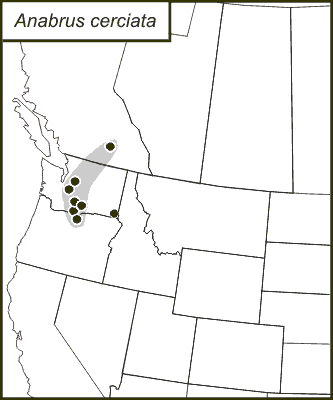



The record in the extreme southeast corner of Washington state is from Asotin County, WA. It was emailed to TJW in June 2018 by Robert Srygley (USDA) who credited the record to George Bruno (USDA APHIS PPQ).
In an 11 March 2020 email to Robert Srygley, George A. Bruno gave this account of finding Anabrus cerciata in Asotin County, Washington:
“My first recollection of A. cerciata in the Couse Creek area, south of Asotin was July 2008 when I observed them during our annual adult grasshopper survey in Asotin County. Throughout the years we have only observed low densities of Mormon crickets1 in this area, primarily in range areas along Couse Creek road. Our grasshopper scouts return to this area each year and have never observed high cricket populations in any of the agriculture areas on the plateaus and benches above the Snake River. The crickets are mainly scattered along Couse Creek Road going up the grade approximately 5-6 miles, to where Couse Creek road turns into Sherry Grade near the top of the Plateau where most of the agriculture production is located. Cropland on the benches and plateaus mainly consists of dryland wheat, pasture and hayland. There are a lot of switchbacks sidewinding up the canyon along Couse creek road and this is where most of the crickets tend to congregate. The hillslopes above the road are mainly rangeland, dominated by range grasses (cheat, bluebunch wheatgrass, Idaho fescue, etc.), sagebrush and other shrubs. The valley bottom of Couse Creek near the Snake River is well-vegetated along the road with alder, cottonwood and occasional willows where we also occasionally observe crickets.”
1 For those keeping track of potentially damaging Anabrus spp., the common name “Mormon cricket” includes all four species of Anabrus, including A. simplex and A. cerciata.